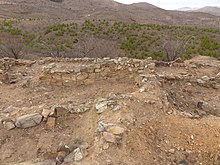Torrecid
Torrecid was a Christian mota located in the municipal district of the Aragonese town of Ateca, Zaragoza, Spain, El Cid camp in the Jalón river valley. It has remained buried for almost a thousand years until recent archaeological excavations have found it where described by the author of Cantar de Mio Cid. To date the Government of Aragon has not cataloged it so its protection is the generic indicated in the Decree of April 22, 1949 and Law 16/1985 of protection of the Spanish Historical Heritage.
| Torrecid | |
|---|---|
| Native name Spanish: Castillo de Torrecid | |
 Location of Torrecid in Spain | |
| Location | Ateca, Spain |
| Type | Non-movable |
| Criteria | archaeological site |

History
Located on the right bank of the River Jalón, it is one of the most important castles in the development of the epic Cantar de Mio Cid. It is located in the area, now called Torrecil, in front of the so-called La Mora Encantada, where Alcocer was located, separated from it by the channel of the Jalón river and about two thousand meters away. The facts described in the song are situated around the year 1081.
The hill where El Cid camped for fifteen weeks according to the lay, is the place called Cerro Torrecid or Otero del Cid where the ruins that occupy us are located and it is a temporary fortified camp (mota), rather than a castle proper, next to the one that would settle the tents that the Cid would take because according to the lay they were accompanied by three hundred knights and three hundred pawns that obviously had no place inside this small fortification. From here they could watch Alcocer separated only by the river Jalón.
Modern Times
There is scarcely any remains of the fortification that was built in a short time by the men of El Cid, but only a few walls of masonry, covered with mud, barely half a meter high, which makes it possible to see the layout of the small fortified enclosure, it had a watchtower of about ten meters of height, placing the tents of the camp around the recito. It has been possible to construct plans of seven rooms and numerous remains of ceramics of the eleventh century have been found. The highlight of these remains is that if we stand on them we can easily see in front of them the remains of the Alcocer, to the right we see the town of Terrer and left the town of Ateca who at that time paid pariahs.
Legal protection
It is protected within the generic declaration of Cultural interest of all the castles of Spain by the Decree of 22 of April 1949 and Law 16/1985 of protection of the Spanish Historical Heritage.
Sources
- The information in this article is based on that in its Spanish equivalent.
External links
- Torrecid in The Way of El Cid(in Spanish)